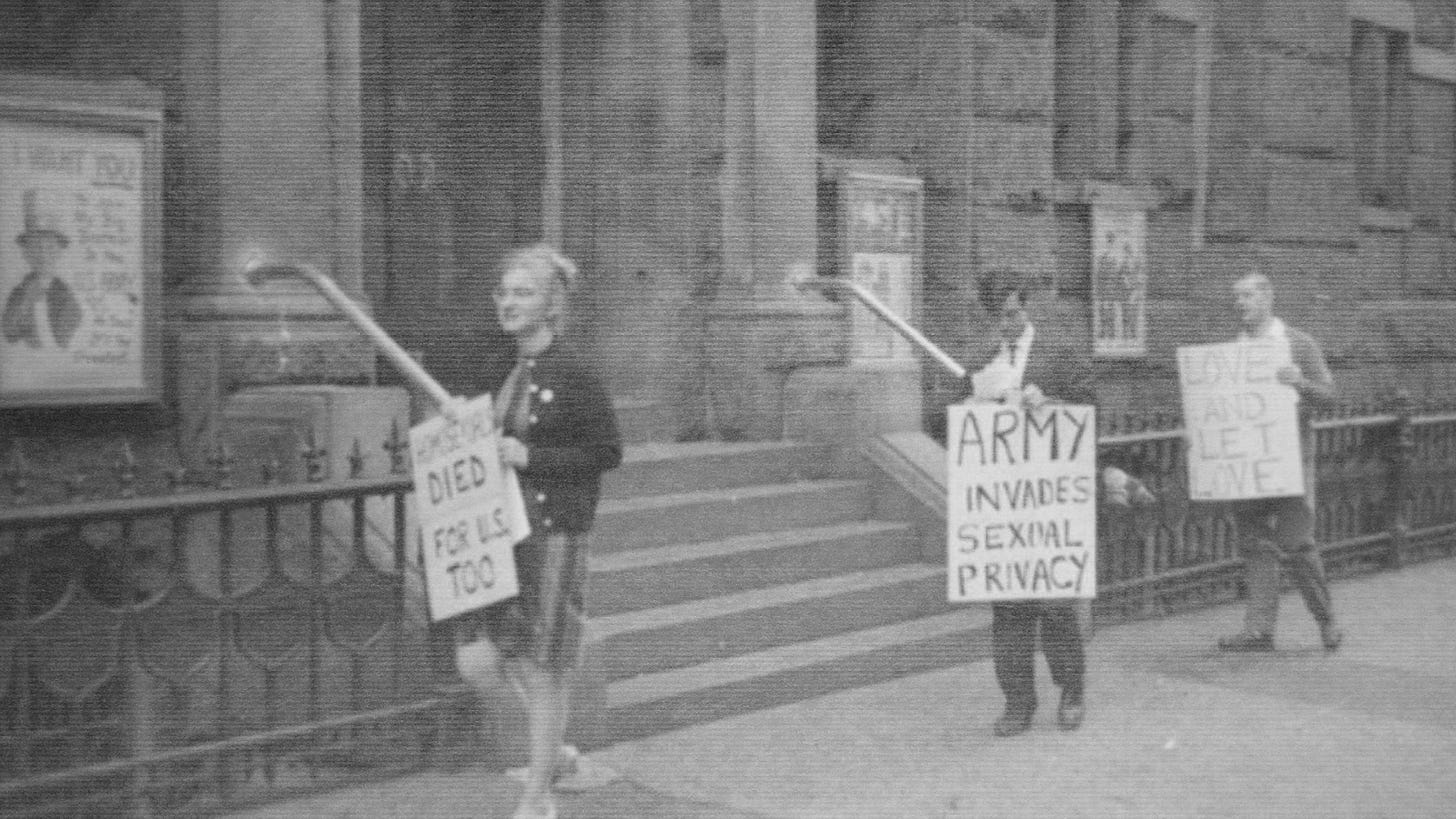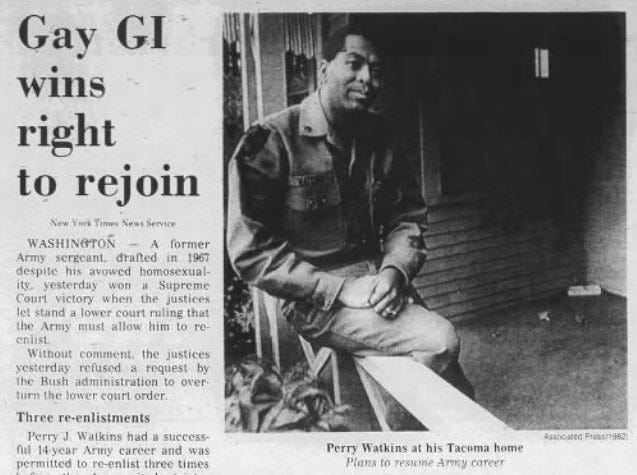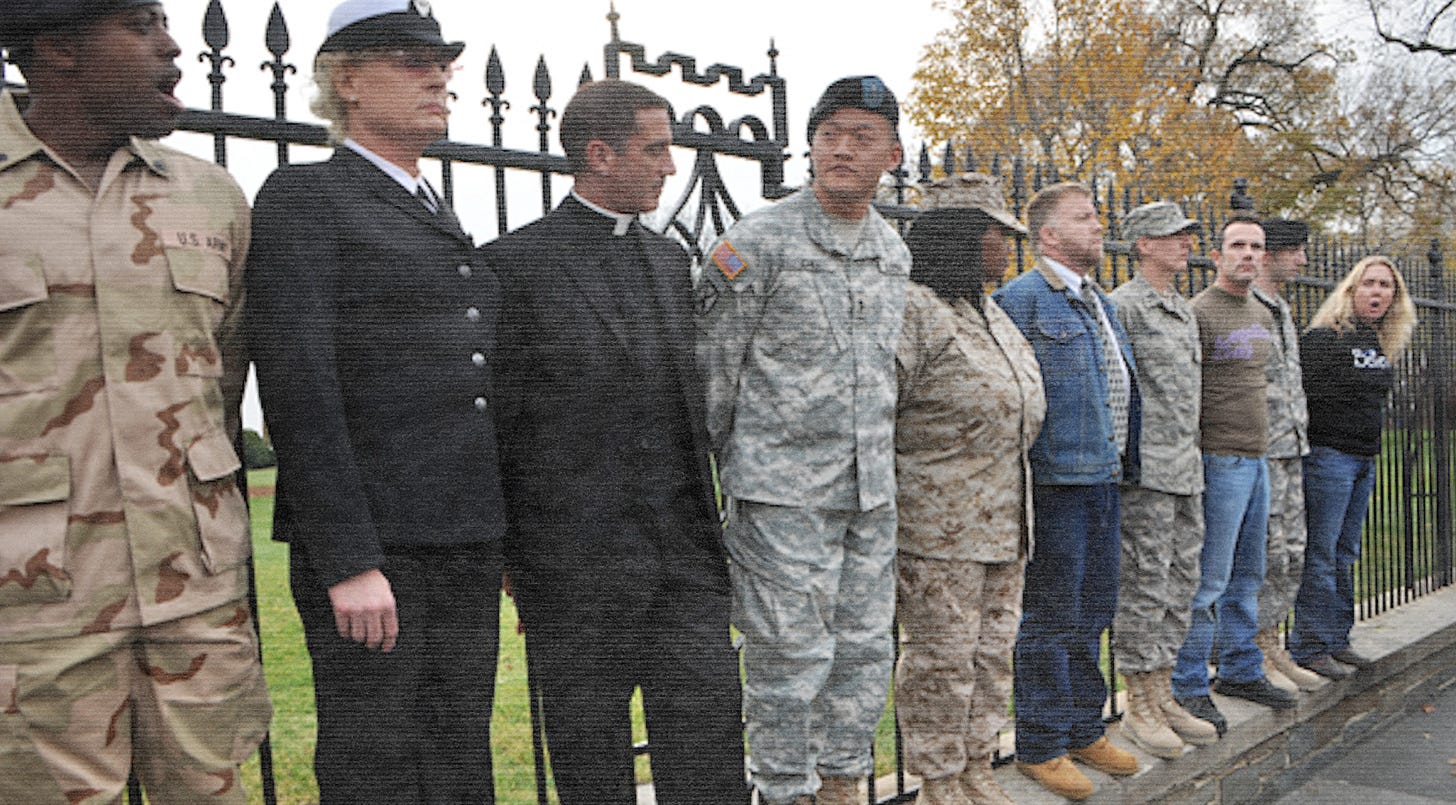The Coming Purge of Trans Troops in Context of Broader LGBTQ Struggle
A US Military History of Tragedy and Victory in the Equality Movement
Article by Mike Prysner
Trump and Hegseth have a two-pronged agenda for the US military: the first is its use as a domestic police and repression force, which I wrote about in January. The second is to Make the Military Warfighters Again–based on the ultra-online belief that the ranks have become a liberal bastion catering to unqualified slobs and woke indoctrination. The belief they must be transformed into a singular VetBro archetype, a military that will look really badass on Instagram–most importantly, no posts by soldiers that could be shared by Libs of TikTok. (They think there’s too many women, too).
On May 6, they were handed another victory for this second pillar as the Supreme Court issued a decision allowing them to conduct a massive purge of Transgender service members and ban them from enlisting. The military says 4,240 of its troops officially “suffer from gender dysphoria” but estimates of the true number reach 15,000.
The incoming purge would end what was less than a decade of Trans people being allowed to serve, after Obama lifted the ban in 2016. Prior to that they were formally banned, though still found ways to join under the radar. Many were kicked out for being discovered.
The vast majority of Trans enlistees identify as Transgender before joining. According to a study in the National Library of Medicine: “transgender persons appear twice as likely as members of the general population to serve in the military; 20 percent of respondents from the National Transgender Discrimination Survey had served in the military, compared to 10 percent of the general population.”
Much of this could be attributed to Trans people in uniform having been able to, since 2016, receive gender-affirming health care through the military, as well as escape issues like homelessness and unemployment that disproportionately impact Trans youth. 34 percent of Trans service members report they had experienced homelessness. (The average age of enlistment is 19).
The pivot by the Obama Administration repealing Don’t Ask Don’t Tell in 2011, and then in the Trans ban in 2016, was not indicative of a liberal (or “woke”) Pentagon as asserted by the right wing. Rather, it was a necessary adaptation for the war machine to retain legitimacy in a changing society. By that time, a clear majority of Americans supported equal rights across the board of LGBTQ people. So for state institutions to remain credible in the eyes of its population (and potential enlistees) it would have to adapt.
But it was also pushed to do so, as the broader equality struggle often centered on the military. With the incoming attack of LGBTQ rights, it could again become a trigger for a fightback.
A History of Bigotry
Abuse and repression against LGBTQ troops has, in many ways, increased over the decades leading up to the repeal of Don’t Ask Don’t Tell, rather than a gradual softening.
“Homosexual acts” had been unofficial grounds for punishment and discharge since the Revolutionary War. The Articles of War of 1916 formalized this, making “intent to commit sodomy” in the military a punishable crime.
In the 1940’s the US military began “psychological” screenings for GIs to determine if they were gay or not.
In 1982, the Department of Defense ramped up with a new, clearly-defined policy: “Homosexuality is incompatible with military service,” disqualifying or discharging anyone with “a propensity to engage in homosexual conduct.” In the subsequent two years, nearly 4,000 GIs were kicked out on suspicion of being gay.
During this time they also ramped up anti-Trans discharges, fighting for the right to do so when challenged in court.
It is notable that in the 1986 Supreme Court ruling upholding bigoted “anti-sodomy laws” in 25 states, it did so from a challenge to the anti-gay discharges of Miriam Ben-Shalom, a drill sergeant in the Army Reserves, and James Woodward, a Navy sailor.
This accelerated anti-LGBTQ witch hunts. Despite attempts to keep their sexuality in total secrecy, military units carried out invasive investigations against anyone suspected of being gay.
Women in particular were targeted. In 1988 alone, at a single Marine training headquarters at Parris Island, 65 “suspected lesbians” were purged after such investigations into their personal lives. While many were given the option to “resign with dignity,” (especially the officers), 18 were given dishonorable discharges–the equivalent of a felony charge in the civilian job market. Three of them were convicted of “sodomy” and sentenced to prison.
The growing struggle for LGBTQ equality and protection from discrimination in the military had become such a force that Bill Clinton had to make lifting the ban a campaign promise to win the 1992 election.
Immediately following his victory, the Pentagon staged a campaign to prevent any reforms in the anti-gay policies, led by General Colin Powell, who made the formal declaration: “The military leaders in the armed forces of the United States—the Joint Chiefs of Staff and the senior commanders—continue to believe strongly that the presence of homosexuals within the armed forces would be prejudicial to good order and discipline.”
Clinton abandoned his promise in the face of this pressure, and instead implemented the Don’t Ask, Don’t Tell policy in 1994. It meant, as the name implies, military commanders could not “ask” if a subordinate was gay, but LGBTQ service members could not admit their sexuality–if they “tell,” they will be reprimanded and kicked-out just like before. Anti-sodomy laws still stood.
While it was framed as a victory, it was used to further persecute gays in the military. Anti-gay discharges actually increased following it’s passage–while 597 were discharged the year before DADT, 997 were discharged under DADT in 1997.
This open atmosphere of anti-gay sentiment and harassment culminated in the 1999 anti-gay hate crime and murder of Private First Class Barry Winchell of the Army’s 101st Airborne Division by fellow soldiers. PFC Winchell’s leaders had ignored, and likely encouraged, harassment against him for dating a Trans woman. This fostered an environment in his unit that led to him being attacked in his sleep and beaten to death.
PFC Winchell’s murder, again, increased the military’s repression of LGBTQ troops. In the following years they kicked-out more for being gay than ever, with 1,212 DADT discharges in 2001.
In my own experience, I recall a Staff Sergeant while I was in training in 2001, bragging to me (unsolicited) about how he would organize nighttime beatings of soldiers perceived to be gay in his unit. This was the culture reversed by what Hegseth calls “DEI.”
This policy remained until Obama’s repeal in 2011. It will likely be the next target after Trump and Hegseth complete their Trans purge.
A History of Struggle
This long track record of repression has always paralleled one of struggle. This wasn’t really just about fighting for the rights of LGBTQ people in the military but, as I wrote about regarding the Civil Rights movement, was used by the gay rights movement to hit at a weak point: using the country’s worship of the military, and the reality that gay people were “serving this country,” as a mechanism to advance the broader equality struggle.
It should not be lost on readers that the first ever public demonstration for gay rights in America was held in front of a US Army building, protesting the Pentagon’s discriminatory policies. On Sept. 19, 1964, members of the Homosexual League of New York, picketed outside an Army office in Lower Manhattan (pictured below).
They distributed leaflets which read: “We protest the military policy of defaming sexual ‘deviates’ and ‘offenders’ by giving them less-than-honorable discharges, and revealing draft information on private sexual matters to federal and state agencies.” Many people’s lives and livelihoods were destroyed by this practice.
The movement continued to organize around discriminatory military policies, as well as use gay veterans to campaign for acceptability.
Similarly, the first ever major media headline featuring a “coming out” was a uniformed service member.
Leonard Matlovich was a Technical Sergeant in the Air Force. In Vietnam, he won a Bronze Star for “valor” and Purple Heart for being seriously wounded when he stepped on a landmine. He would go on to become the most-known gay man in the country–alongside Harvey Milk–while still in uniform.
He became the first GI to purposely out himself as an act of civil disobedience against the military’s anti-gay policy. In response, the Air Force tried to make him sign a document pledging to "never practice homosexuality again," which he refused. In 1975 he appeared in uniform on the cover of Time Magazine with the title, “I Am a Homosexual.” It was a resounding effect for LGBTQ people around the country, and is considered a turning point in the struggle for recognition and acceptance.
In 1988, five significant LGBTQ, women’s and civil rights organizations joined forces to form the Gay and Lesbian Military Freedom Project.
Around the same time, African American soldier SSG Perry Watkins was waging a fight to stay in the military while openly gay. Ultimately discharged for being gay in 1981. But Watkins continued fighting in the courts, and in 1990 actually won a reversal, awarding them an Honorable Discharge.
These were premiere struggles against anti-gay discrimination at the workplace, and strengthened to movement nationwide.
As the broader LGBTQ movement accelerated, so too did a focus on the military. In 2010 two Army officers recently kicked out for being gay, Dan Choi and James Pietrangelo, led a protest with other veterans chaining themselves to the White House fence.
It is also worth mentioning that it was the bravery of a Trans soldier, Chelsea Manning, who played a pivotal role in bringing the Iraq war to an end by exposing the depth of US crimes to the Iraqi people and the world.
Just The Beginning
We all know that the MAGA movement has a much bigger agenda for all LGBTQ people in America. Their targeting of Trans service members is just one step, as they denial of rights in that arena will be easy for them.
I don’t think anybody should join or remain in the military. But that doesn’t mean we shouldn’t treat these attacks as an attack on the community as a whole–or see it as an opportunity, like the LGBTQ movement in the past, to use it as an arena to defend rights for everyone.
The nationwide movement that forced the passage of Marriage Equality could again be mobilized to fight the reactionary Trump agenda, and the attacks on Trans troops could be used as a trigger.
And we must use this moment to show service members that this system doesn’t care about them. A significant portion of the government is out to strip them and their friends of rights while the “opposition” in government barely lifts a finger, united only in defending war and corporations. This is who they are serving and defending, not the American people, and our real fight is in the streets.















You talked about the Ls and Gs of the past, but not of the present. Not once. Seems to me that the interests and desires of the LGB community don't have much in common with that of the TQIA bunch.
It's pretty easy to see why. The former are hardwired with different sexual preferences than most of us, just like some people have blue eyes and others brown. The others are making a conscious choice, or pretending to be something they are not.
The LGBs only wanted equal rights, the TQs, especially the Ts, demand supremacy, and they are the only ones being booted out of the military.
Just saying they shouldn't be lumped together because their interests are completely different, and the LGBs already won their fight for equality, and deservedly so. The end of the artificially manufactured, deliberately divisive, and very profitable transgender movement is very good for their long-term interests.
"I don’t think anybody should join or remain in the military." That statement, with which I agree, is all that really matters. The idea that anyone who is not a hyper-masculine, psychopathic, sociopathic murder-rapist should want to serve in the military is naive at best. The idea that such people should fight for the "right" to serve in an imperialist military that has no regard for human rights is not only laughable, it is disgusting.
"Serving" in the military does not serve any human values whatsoever. There is no compassion, conscience, empathy, honor, humility, integrity, or respect (for anything other than the chain of command) in the US military and hasn't been since at least 9/11.
I learned that the hard way while serving in Afghanistan and then domestically during Operation Katrina. That is precisely why I chose to ETS after 15 years of service--walking away from a promotion, retirement pension, and a $20,000 reenlistment bonus in 2005. It took me several years to regain my humanity after leaving the military, so why should anyone want to join such an inhuman institution simply to assuage their ego and externally affirm an internal identity? Preserving, protecting, safeguarding, and nurturing one's Humanity is far more important than externally affirming one's identity. Again, I learned that the hard way.
There is no changing an institution from within, certainly not from the bottom. And as we who served all know, service members are government property who have no rights. That is the reality that those trying to fight for LGBTQ+ rights in the military refuse to acknowledge.
There are options to military membership that offer real service and training and both recognize LGBTQ+ status and support it. One such example is the Socialist Rifle Association. Another option is to create something new instead of trying to fight the old. That way, you actually give those in the LGBTQ+ community a meaningful and safe option to military membership.
It has been widely expressed throughout modern times that whatever you give your energy to persists. If you're constantly fighting against discrimination or against war, then discrimination and war will persist. But when you start working to create an alternative, when you apply your energy toward the opposite, then you invite change. Is that not what we want? If so, then perhaps we need to reevaluate our priorities ... and redirect our efforts.